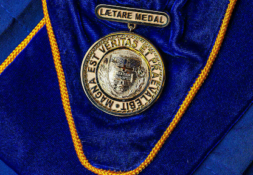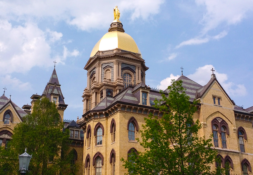Class of 2028 most competitive to date
Notre Dame announced regular decision admissions for the Class of 2028 on Monday, March 18. The university admitted 1,600 students from a pool of 18,455 applications. Including restrictive early action decisions, the acceptance rate for the class was 11.1 percent, down slightly from 11.9 percent last year and almost half of the 22 percent acceptance rate for the Class of 2018.
The university’s acceptance rate has fallen every year since the Class of 2022 cycle. A large factor in the plummeting acceptance rate is the increase in total applications. This year, 29,943 students applied for admission, an increase of almost 10,000 since the Class of 2022.
This admissions cycle marks the fourth year that the university did not require applicants to submit a standardized test score, and the university has announced that it will remain test-optional through at least the Class of 2029.
Other selective universities such as Yale, Dartmouth, and MIT have recently reversed their test-optional policies put in place during COVID and now require applicants to submit standardized test scores.
In Yale’s press release on the matter, the university stated that, when reviewing the effects of the policy, they found it “frequently worked to the disadvantage of applicants from lower socio-economic backgrounds.” The release also stated that “among all application components, test scores are the single greatest predictor of a student’s future Yale grades. This is true even after controlling for family income and other demographic variables.”
Dartmouth similarly found that “high school grades paired with standardized testing are the most reliable indicators for success in Dartmouth’s course of study. Test scores represent an especially valuable tool to identify high-achieving applicants from low and middle-income backgrounds, who are first-generation college-bound, as well as students from urban and rural backgrounds.”
In a June 2023 press release Micki Kidder, Vice President of Admissions at Notre Dame, spoke in favor of the policy: “A test-optional practice ensures that all high-potential students who have a desire to contribute to the Notre Dame mission can apply and know that their applications will be reviewed in a comprehensive manner. Standardized test scores are just one of many important elements of a young person’s application.”
Kidder continued, “I am grateful that Notre Dame continues to review applications for growth in virtues and celebration for the many attributes of a young scholar, well beyond a single test score.”
In comments to the Observer earlier this month, Kidder reported that while 56 percent of all applicants did not submit a score, this group comprised only about a third of admitted students. This suggests that a student chosen randomly from the pool that submitted scores would be more than twice as likely to be admitted as a student chosen randomly from the pool that did not submit scores.
The test-optional policy is not without detractors. David O’Connor, professor of philosophy at Notre Dame, stated that the university is no longer chiefly concerned with intellectual ability in its admissions decision process. Speaking to the Rover, he said that the primary task of the admissions department ought to be to “distinguish between people who are simply good at accumulating credentials from those who really display penetrating and creative intellectual talent.”
O’Connor observed that the admissions department has instead begun to focus more on sociability: “To displace that primary task into a search for a certain kind of sociability is likely to both be ineffective and to diminish the intellectual quality of our best students, or to give us fewer students who have the highest level of intellectual quality. I see the elimination of the SAT as designed to give freer reign to the admissions department in the search for sociability rather than intellectual distinction.”
Brian Mulholland, an assistant professor of mathematics with a research focus in math pedagogy, thinks that it is hard to disentangle the test-optional policy from other factors in evaluating potential academic shortcomings of the students. He told Rover, “Ultimately, I am supportive of viewing students holistically and not simply based on a single factor like the SAT. As for general student aptitude, the learning loss due to the COVID-19 response has markedly impacted mathematics education. Formative mathematics has demonstrated the least resilience in the recovery phase.”
Mulholland continued, “Given that admissions policies were introduced during the COVID and post-COVID era, personally I believe there is insufficient data to conclusively determine the effects on overall student proficiency. To me it remains unclear whether the observed challenges in student aptitude are directly attributable to SAT admission policies or if they are residual impacts of the pandemic.”
In a 2022 interview with the Rover, former Associate Vice President for Undergraduate Enrollment Don Bishop expressed some concerns over the direction of the test-optional policy. He said, “If the trends we saw this year and last year [2021 and 2022] persist, and if the students applying to the most selective colleges seem to withhold their test scores if their scores are below the median score for enrolled students, then it is likely that many of the most selective colleges will elect to return to requiring the test.”
Bishop also described how high schools are adjusting to the change in testing policy. He explained, “High schools increasingly are altering rank in class data to cluster many students to be ranked number one in the class. Some schools are ranking as many as one-fourth of all their students as number one.”
The Rover report from 2022 also illuminated a drastic change in the number of waitlisted students. This 71 percent increase in the amount of waitlisted students from 2020 to 2022 was reflective both of the increased difficulty in discerning the quality of student and of an explicit effort by the university to maintain their relationship with high schools.
Bishop explained, “When you have a jump in applications like we did, you expand the waitlist to protect the high school counselors. It shows them that they were close.” He clarified that it often takes several years for people to adjust to a more selective acceptance rate, but the wait-list sends the message of “denied with honors” and protects the credibility of the high school.
Notre Dame has not shared the waitlist numbers for the last two admitted classes.
In addition to the test-optional policy precluding consideration of standardized, quantitative academic performance in college admissions, this year also marks the first time admissions counselors were prevented from considering race in their decisions.
After the end of the admissions cycle in 2023, the Supreme Court case Students For Fair Admissions v. Harvard held that Harvard’s use of race in admissions was unconstitutional. Notre Dame signed onto an amici curiae brief in support of race-conscious admissions, but it is unknown what changes, if any, the university has made in the wake of the ruling. No data is available on the racial composition of the incoming class, but more information should be released after accepted students enroll.
No data was available regarding what percentage of the admitted cohort is Catholic, although historically this number has held steady around 80 percent. Accepted students have until May 1 to confirm their enrollment.
Will Grannis is a junior pure mathematics and theology major living in Steds. Contact him at wgrannis@nd.edu.
Photo Credit: Carol M. Highsmith Archive, Library of Congress. Image of Main Building, Notre Dame
Subscribe to the Irish Rover here.
Donate to the Irish Rover here.





